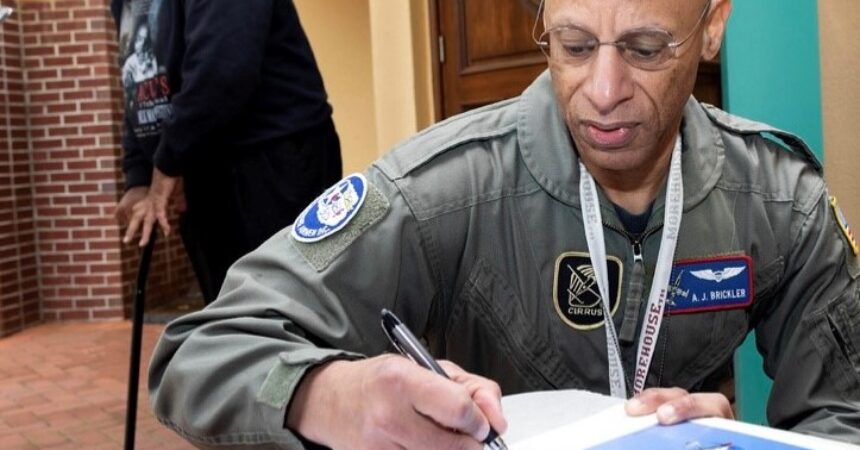
Brickler routinely demonstrates Tuskegee Airmen influence

Photo by Christian Whittaker
By Kerrie Wetherspoon
Special to the Outlook
Almost every time that Dr. Andrew Brickler isn’t in his white coat, what he wears makes him a walking billboard of sorts.
He is deliberate about it, too. Brickler purposely wears clothing that fashions the renowned Black military pilots, Tuskegee Airmen.
“I wear my Tuskegee shoes or shirt every day because I want someone to ask me about it,” Brickler said.
Brickler decided to pay homage to the group after meeting some of the Tuskegee Airmen more than a decade ago when they were being celebrated at an air show in Oshkosh, Wis.
The Tallahassee physician had a chance to talk about the Black airmen during a presentation at Tabernacle Missionary Baptist Church. Brickler, who is known for his in-depth stories about the Tuskegee Airmen, appeared last Sunday at a Black History Month celebration put on by the Martin Luther King Foundation of Florida.
“It’s a shame,” said Brickler, referring to how little is known about the pilots and how pivotal their role was during World War II.
As part of his effort to build awareness about the airmen, Brickler has been the driving force behind an annual appearance by the Red Tail Rise Above Project to Tallahassee for the past 12 years. The Tuskegee Airmen Plane “P-51” is in Tallahassee at the Tallahassee International Airport.
It is parked near the General Aviation terminal until Saturday from noon to 3 p.m. The event also features a 15 minute film about the airmen.
The Tuskegee Airmen were Black servicemen in the Air Forces. They were trained at Tuskegee Army Air Field, a segregated airbase in Alabama.
The group was made up of almost 1,000 aviators who were active from 1940 to 1946. Among them were five pilots from the Haitian Air Force and one from Trinidad, while at least one other of the airmen was a Dominican Republic native.
Their story had been virtually unknown until it became part of documentaries about former President Harry Truman ending segregation in the military during the summer of 1948.
“People like the Tuskegee Airmen,” said Bricker, himself a pilot with More than 2,000 hours of flight time. “They show you that we have to pull an extra load because people are going to judge us by the color of our skin, but once we get past that you can make people believe.”
While coping with segregation in the military, the airmen stayed true to the importance of their role during World War II. They were in-charge of escorting bombers, not just Americans but allied bomber in some cases.
Last May one of the last two surviving members, Lieutenant Colonel Asa D. Herring, died last year at age 95. It is believed that the lone remaining member lives Arizona.
“I wish there were more young people to see what Blacks did to help this country in World War II,” said Steve Beasley, president of the MLK Foundation. “Anybody can drive a tank but very few people can fly an airplane.”
Brickler’s presentation was a full-circle moment for Beasley.
“It is personal because my father was born in Tuskegee,” he said. “Our family’s land is connected to the Tuskegee Airport where the Tuskegee Airmen trained.”







